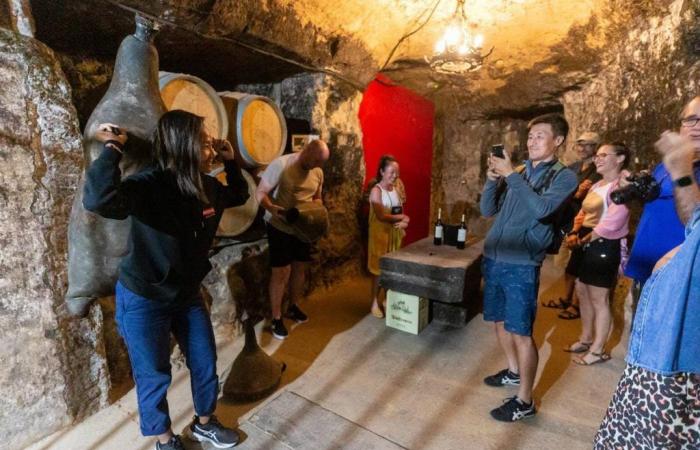Just two decades ago it was difficult to find a winery willing to open its doors to the public, especially on weekends and holidays, to show the customer what was happening inside. The wine tourism activity was developing little by little and was not even … professionalized. Quite the opposite of what is happening now in the Denomination of Qualified Origin (DOCa) Rioja, where it is already an increasingly relevant business for the income statement of both wine companies and everything that surrounds the world of wine. .
This economic impact generated by wine tourism is already close to 186 million euros, one third – 61.98 million – directly in the wineries and the other two – 123.96 million – in the rest of the sectors of activity within the territory of the DOCa. Rioja (accommodation, hospitality establishments, commerce, transport services…), according to the latest monitor prepared for the Regulatory Council with data from 2023.
«There is a direct and immediate return in the winery. It is the best way to build customer loyalty, to become ambassadors of our Rioja wine,” highlights José Luis Lapuente, general director of the Council. “Any asset and any resource linked to wine tourism is attractive,” he adds. Because unlike sales, which fell 5.2% last year, the inertia of this activity is radically opposite. The volume of visits amounted to 879,423, growing by 17.5% compared to the previous year and, more importantly, by 2.5% compared to the pre-pandemic, to a 2019 that until then was a record year (858,107 ). And billing has also evolved upwards, with an increase of 19.5% over 2022 and 7.3% compared to the pre-covid period.
Growth room
“But there is still a lot of room for growth,” says Inma Bezunartea, manager of the Rioja Wine Trips tour operator. To achieve this, she considers it “determining” to improve promotion in the countries that send visitors. “It is necessary to sell our product and all its charms there,” as wine appellations from France or Italy are doing. And in parallel, “we must associate the wine and wineries of Rioja with its gastronomy, because there we do have the upper hand.” On the other hand, there is an aspect that “is of concern in the sector” – and by extension in the entire autonomous community – which is the chronic deficit of infrastructure. “It doesn’t depend on us,” laments Bezunartea, but it does hamper their activity “because to bring tourists, especially foreigners, sometimes two or three connections are needed to get here. And that is sometimes exasperating.

Expanded winery visiting hours adapted to the needs of tourists, personalized experiences, better communication of the offer to the client through a search engine or a greater range of spaces for wine tasting and gastronomy tasting are other aspects. susceptible to improvement, according to the Wine Tourism Monitor of the Regulatory Council, to consolidate Rioja as a reference destination. “Reaching the goal set for the year 2025 and then reaching 1.2 million visits is perfectly feasible,” says Lapuente.
«The challenge we set for ourselves of reaching 1.2 million visits by 2025 is feasible»
José Luis Lapuente
General Director of the Regulatory Council
«The ability of wineries to adapt to the market and create things is remarkable»
Virginia Borges
Director of Tourism of the Government of La Rioja
«We must improve the promotion carried out in the tourist-sending countries»
Inma Bezunartea
Rioja Wine Trips Manager
To do this, it will be necessary to involve a greater number of wineries – a total of 204 now open their doors to the public and the aspiration is to reach 250 in one year -, ensure that the activity is carried out at full capacity in winter as well, and recover a greater presence of foreign visitors – their purchasing power is usually higher – because before the global health epidemic they represented almost 37% and now that proportion does not reach 33%.
The wine tourism model in Rioja “is not exhausted, there is still significant room for growth,” says Virginia Borges, general director of Tourism of the regional government, “and it must be irremediably aligned with social and consumption changes.” In short, you have to know how to listen to the customer and know their tastes “but the ability of our wineries to create new things and adapt to market trends is beyond any doubt.” In addition, investments are on the rise and last year they allocated more than two million to improvements in wine tourism, double that of 2022.
Gastronomy and wine
The Rioja Executive is clear that “the commitment must be to wine and gastronomy,” says Borges, and, in this sense, the Barrio de la Estación tasting this weekend “is a good example of an event that captures attention » outside our borders. These types of quotes are what contribute to “raising the perception of Rioja and that is where we have to go in the Denomination of Origin,” says Bezunartea.
Right now “we have a winning option” and, what is more important, “with a wide margin for improvement and with the conviction of the different operators that we must influence collaboration between all of them and propose content and products.” of quality,” highlights José Luis Lapuente.
The time to visit the winery almost to cover the file and accompany it with some wine has passed. Now the offer has evolved in such a way that to this tour through the bowels of historic buildings that is finished with a select tasting are added walks among vineyards, experiences such as treading the grapes or the harvest itself, lunches at the foot of the vineyard, escape room… «Customers mark their preferences. “You have to listen to them,” concludes the manager of Rioja Wine Trips, who works mainly with North American tourists, the most loyal foreign clients to Rioja.
University graduate with a high level of English, the typical profile of the sector professional
With the rise of wine tourism, the creation of jobs has also experienced notable growth. It already generates 520 direct jobs and another 180 indirect jobs. The wineries have, on average, two full-time employees and another two part-time, to cover peaks of maximum activity. The profile of professionals is also changing, for the better, because almost three quarters have university studies and even three out of ten have a master’s degree. 91% of those who work in wine tourism already speak English, but there is another discipline such as social media management in which DOCa Rioja wineries demand greater training for their professionals.






